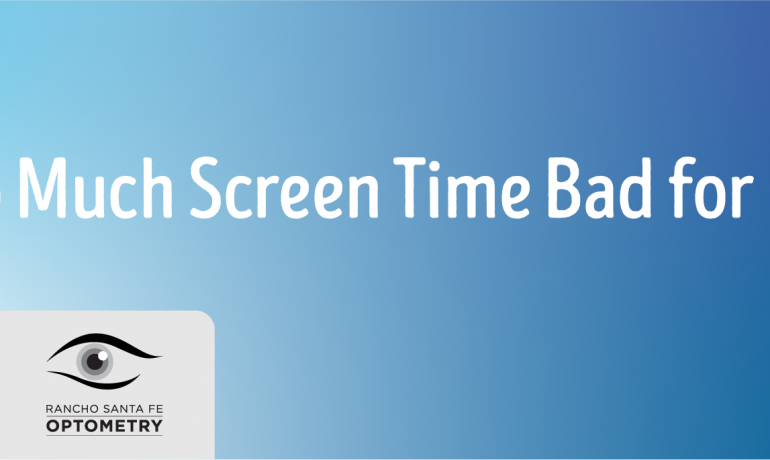Children and their phones are inseparable today, and all that reading and playing games on their handheld devices may be harming their vision.
“Screen time” refers to the amount of time a person spends staring at the digital displays of computers, tablets (iPads, for example) and smartphones. According to The Vision Council, 72 percent of American parents report their children routinely engage in more than two hours of screen time per day. It’s very likely most kids actually spend significantly more time staring at screens than their parents think they do.

As kids grow, their screen time tends to grow with them. Even very young children are spending a significant amount of time each day staring at screens. According to Common Sense Media, young children in the U.S. spend the following amount of time each day using digital devices:
- Kids under 2 years of age: 42 minutes per day
- Kids ages 2 to 4: 2.5 hours per day
- Children ages 5 to 8: nearly 3 hours per day
Why might this be a problem?
30% of parents report that their child experiences one or more of the following after being exposed to two hours of screen time:
- Headaches
- Neck/shoulder pain
- Eye strain, dry or irritated eyes
- Reduced attention span
- Poor behavior
- Irritability
All of these symptoms can easily effect academic performance and social interactions.
What is blue light have to do with screens?
The LED screens of computers and portable digital devices emit a broad spectrum of visible light. Most of these light rays are harmless, but a portion of the light emitted by these screens is relatively high-energy visible light called “blue light” named for its location on the color spectrum.
Blue light has a shorter wavelength and higher energy than other visible light rays. Laboratory research suggests certain bands of blue light may be harmful to the light-sensitive retina of the eye over time.
Blue light also plays an important role in regulating our body’s circadian rhythm. This is our internal clock that’s running in our brain and cycles between alertness and sleepiness at regular intervals over a 24-hour period. It’s also called our sleep/wake cycle. Too much exposure to blue light at the wrong time of day can disrupt a person’s normal sleep/wake cycle. This can lead to serious health consequences.

While the sun emits far more harmful blue light than any digital device ever will, it’s important to point out the timing of exposure. The sun is only harmful while it is out, while blue light from a device can occur at any hour, including well into the night.
Immediate vs. Long-term Risks
Immediate risks start with sleep disruption that can be especially problematic for children. This leads to daytime drowsiness and poor performance in school. Disruption of the sleep/wake cycle also can eventually lead to weight gain and obesity-related health problems. Research has shown that people who experience disrupted 24-hour cycles of sleep and activity also are more likely to have mood disorders, lower levels of happiness and greater feelings of loneliness.
The simple truth is that the long-term risks of incremental blue light exposure from frequent use of digital decides is not yet know. No previous generation has been exposed to comparable levels of blue light from digital devices from childhood on. It might take several decades before the long-term effects are better understood.

For example, researchers in Japan and Switzerland investigated what happened to the retinas of aging eyes from blue light exposure after cataract surgery. In the study, 79 eyes received a clear intraocular lens (IOL) that did not block blue light, and 52 eyes received a yellow IOL that blocked blue light.
Two years after cataract surgery, none of the eyes that received the yellow IOL that blocked blue light showed any new or worsening signs of macular degeneration (AMD). However, among eyes that received the clear IOL that didn’t block any blue light, 15 percent of these eyes showed new or worsening signs of AMD.
The results of this study suggest that the retinas of aging eyes are more susceptible to oxidative damage caused by blue light exposure. If this is true, then it may be prudent and wise to take steps to reduce premature aging of the retina by limiting the amount of blue light exposure the eye receives throughout life.
What can I do about it?
The easiest and quickest way to curtail blue light exposure is to cut back on screen time altogether. If that isn’t an option, wearing glasses that have either a blue light filter or blue light anti-reflective coating is the best option. Even if you or your child doesn’t have a glasses prescription, Rancho Santa Fe Optometry sells glasses with these filters and coatings in a lens that doesn’t have any prescription. Making sure to wear sunglasses while outside will also greatly reduce your risk of developing any eye disease over time.
Don’t have a current prescription or eye health exam? Schedule one today.
At Rancho Santa Fe Optometry we offer comprehensive eye examinations for all ages. With a focus on children’s vision and vision therapy, our doctors test for visual acuity, visual efficiency skills and visual information processing starting in early infancy. The practice also provides diagnosis, treatment and management of diseases that affect the human eye and visual system, including dry eye syndrome, diabetic retinopathy, cataracts, macular degeneration and keratoconus.


